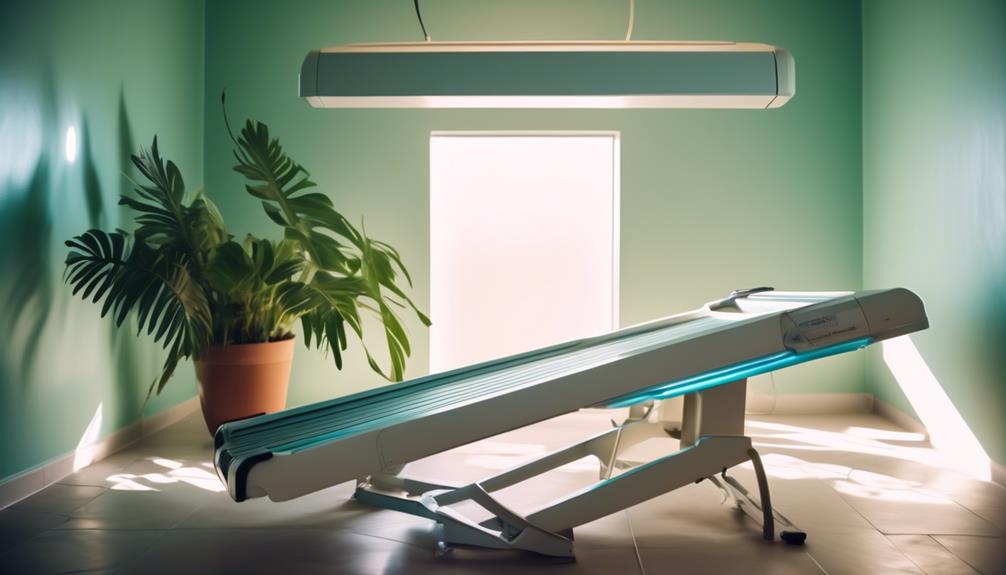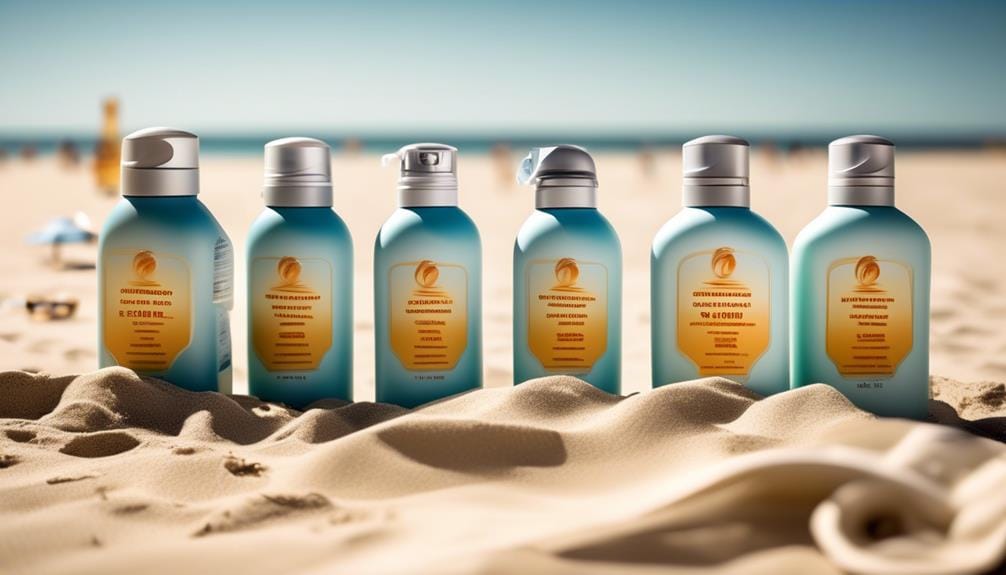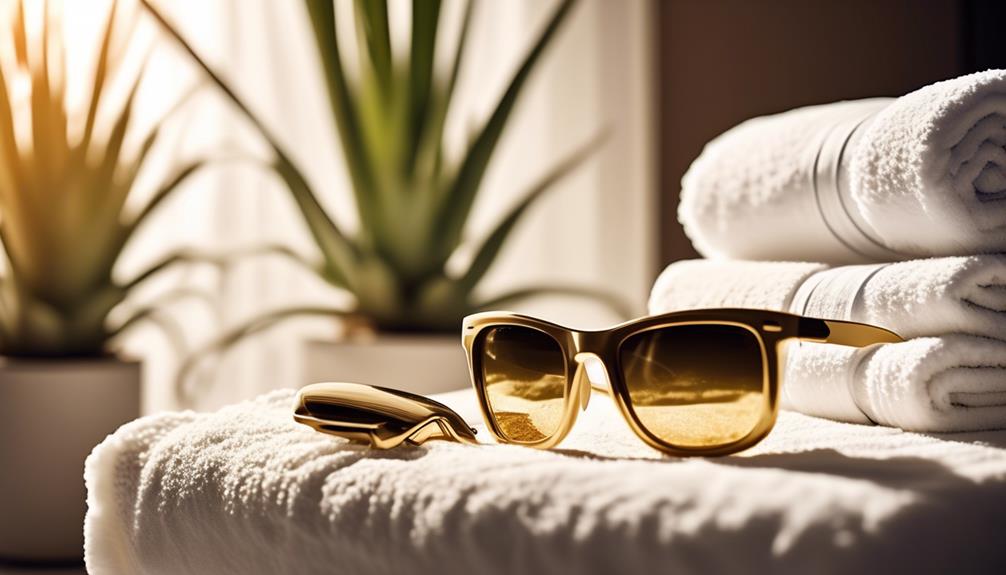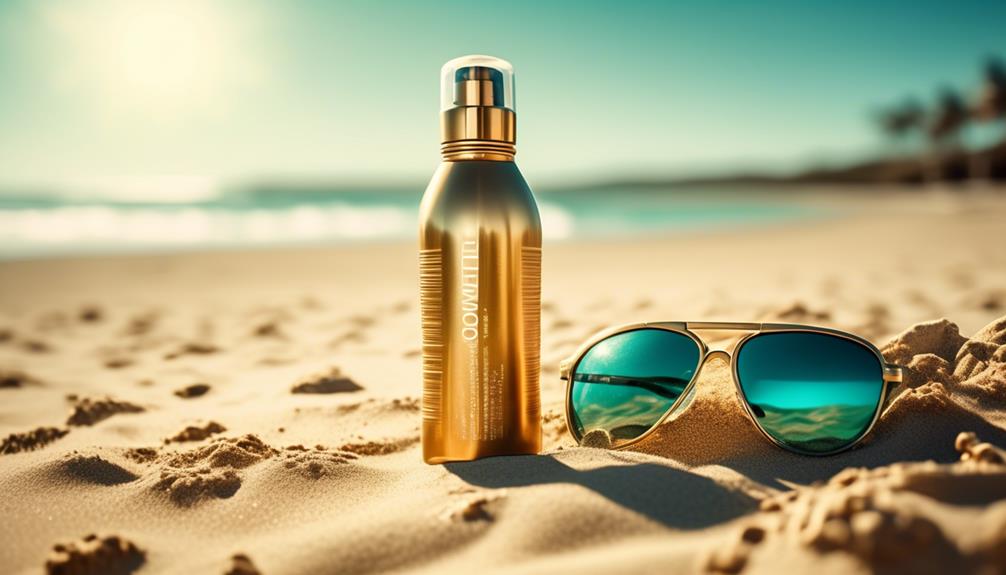Like a fine wine that needs time to breathe, your skin requires a moment to recover after a tanning bed session. You’ve probably heard the buzz about the importance of spacing out your visits, but let’s get real—you might not know why it’s such a big deal.
So, you love the sun-kissed look, and who doesn’t? But indulging in back-to-back tanning sessions can do more harm than good. You see, when you give your skin a break, you’re not just playing it safe; you’re also setting the stage for a deeper, more even tan that lasts.
Now, you might be wondering what the magic number is for those in-between days, and how sticking to it can actually amp up your glow game. Stick around, and we’ll share how to tan smart, not hard, and keep that golden shimmer without the wince-worthy ouch.
Key Takeaways
- Spacing out tanning bed visits allows your skin to adapt to UV rays and prevent burns.
- Gradually increasing the length of tanning sessions helps build a long-lasting and even tan.
- Different skin types require customized approaches for safe melanin production.
- Regularly assessing and adjusting your tanning routine based on your skin’s needs is crucial for maintaining a healthy tan.
Assess Your Skin Type
Before you even dream of hitting that tanning bed, you’ve gotta figure out where you fall on the Fitzpatrick Scale—it’s the key to tailoring your glow-up sessions just right for your skin.
Hon, this isn’t some random quiz; it’s a legit way to determine your skin type and get to know exactly what your skin needs, especially when you’re about to face some serious UV exposure.
Now, if you’ve got fair skin, you’re probably a Type I or II, which means you’ve gotta be extra careful. Your skin is like, ‘Whoa, take it slow with that tan, buddy.’
And for the darker divas, you might be chillin’ at Type III or above, but don’t get it twisted—you still gotta build that tan game slow and steady.
Initial Tan Development
You’re just starting out, so remember, your skin needs time to get used to the UV rays. Kick things off with short sessions to keep it safe and spark that melanin magic.
And don’t forget, spacing out your tans is key—give your skin a 48-hour chill before you hit the bed again.
Skin Adaptation Period
To kick off your glow-up journey, remember that the skin adaptation period is your first step towards that sun-kissed tan, setting the stage for your skin to safely embrace those UV rays. It’s like a warm-up for your skin, prepping it to gradually build up to that gorgeous bronze without the ouch of a burn.
Your tanning schedule should be your BFF during this time, guiding you on when to bask and when to take a break. Too much exposure can cause a world of hurt, and honestly, who’s got time for that?
Balance is key—alternate those sessions and keep your skin quenched. Moisturize like it’s your job. By protecting your skin, you’re not just crafting a tan, you’re curating a vibe.
Melanin Production Safety
Ensure you protect your skin while building your initial tan by being cautious of melanin production. Understanding your skin type is crucial. Excessive UV exposure can be harmful, so take it slow and steady.
Here’s a quick cheat sheet to keep you safe:
| Skin Type | Session Strategy | Hydration Tip |
|---|---|---|
| I | Minimal exposure | Intense |
| II | Build slowly | High |
| III | Moderate build | Balanced |
| IV | Steady increase | Regular |
| V+ | Custom approach | As needed |
Staying hydrated is like sending love letters to your skin—never skip it. Remember, melanin production safety is all about the glow, not the burn. Stay fabulous and tan smart!
Optimal Session Frequency
Let’s discuss how to achieve optimal tanning results.
You’ve gotta find that balance – tan smart by spacing out your visits and never doubling up in a day.
And remember, always chat with the pros to nail down a routine that’s perfect for your skin vibe.
Health Risk Minimization
When it comes to keeping your skin safe while chasing that golden glow, spacing out your tanning bed sessions is key. Health risk minimization isn’t just buzzworthy—it’s your ticket to a sizzling look without the sizzle of UV overexposure.
Gradually build that tan and give a big ‘nope’ to cramming sessions. Remember, it’s a marathon, not a sprint. Chat up those indoor tanning pros to nail down the sweet spot for exposure times, especially for your skin type.
Stick to the golden rule of 3 sessions max per week at first, then dial it down to 2 to keep that radiance on point. And, don’t forget the eye protection—those peepers need shielding too.
If your skin’s throwing a fit or something feels off, it’s time to hit pause. listen up and adjust, because when it comes to UV rays, less is always more.
Tan Development Maintenance
While you’ve got the basics down for minimizing health risks, let’s focus on how you’ll keep that tan game strong by figuring out the best rhythm for your tanning bed visits. Honing in on tan development maintenance is all about understanding your skin’s needs and your base tan’s progress.
Here are a few pointers to ensure you’re glowing just right:
- Start by gradually increasing tanning sessions; it’s like building a relationship, slow and steady.
- Strive for an even tan by spacing out visits—a rushed tan is like a bad date, it just doesn’t look or feel right.
- Keep your skin hydrated; think of moisturizer as the love letter that keeps the tan thriving.
Monitoring Skin Health
Before you hit the tanning bed again, it’s crucial to check in with your skin for any funky changes that could spell trouble. Those tan lines are a hot commodity, but playing it fast and loose with UV-A and UV-B rays isn’t worth the risk. So, let’s get personal with your skin, shall we?
Start by playing detective with your moles and freckles. Notice anything odd, like a change in size, shape, or color? Maybe a spot’s texture feels different than last time you checked. These could be signs your skin’s screaming for a break. And if you’ve got a new spot that’s sticking around longer than a bad date, don’t just ghost it. It’s time to call in a pro.
Now, about those regular skin exams – they’re the real MVPs of monitoring skin health. If you’ve got a history of catching rays or skin cancer in the fam, these check-ups are non-negotiable. So, keep it trendy and safe by spacing out those tanning bed sessions, and always keep an eye on what your skin’s telling you. It’s the ultimate accessory, after all.
Maximizing Tan Longevity
Now that you’ve got your skin health in check, let’s talk about keeping that golden glow going strong.
To make sure your tan lasts longer and keeps you looking like a sun-kissed dream, here are a few trendy tips to maximize tan longevity.
Maintain your skin properly to ensure a long-lasting perfect tan.
- Hydrate Like It’s Your Job: Moisturized skin holds onto a tan way better. So, slather on that hydrating lotion like you mean it, and keep your skin quenched.
- Tan Extenders Are Your BFFs: Invest in a professional tan extender to maintain your glow. It’s like a topcoat for your tan, keeping it fresh and fierce.
- Balance Is Key: Be smart with your tanning bed sessions. Start slow, build up, and never double-dip in a day. It’s all about that even, healthy bronze.
Importance of Recovery Time
Let’s explore why it’s important to give your skin a break between tanning sessions in order to achieve a long-lasting and desirable bronze color.
See, when you’re all about that glow from indoor tanning, it’s super tempting to chase after it non-stop. But here’s the thing: recovery time isn’t just good—it’s non-negotiable.
Your skin’s got to have a moment to chill and repair after soaking up those UV rays. Rushing back into the fray before 48 hours can spell trouble, like overdoing it and ending up with damage instead of that golden touch you’re after. And let’s be real, type of skin matters too. Some can bounce back faster, but everyone’s skin needs that breather.
What’s more, this break isn’t just about avoiding the burn. It’s prime time for your skin to shed any dead skin cells, which means the next time you get your tan on, it’s going to be on point.
Choosing the Right Lotion
When it comes to amplifying your tan and keeping your skin game strong, picking the right lotion is everything. You know how personal tanning is, right? So, let’s get real about tanning lotions. They’re not just about that golden glow; they’re your skin’s BFF, protecting you from dry skin and helping your skin stay nourished and fab.
Now, don’t just grab any bottle off the shelf. Consider these points:
- Match Your Skin Type: Got sensitive skin? There’s a lotion for that. Don’t let irritation cramp your style.
- Think About Your Goals: Are you all about that deep bronze? Different types of tanning lotions can either intensify or gradually build your color.
- Moisturize, Moisturize, Moisturize: Tanning can take its toll. A lotion packed with hydrating ingredients is a must to keep that skin kissably soft.
Adapting to Seasonal Changes
Just like you wouldn’t rock the same lotion all year, your skin needs you to switch things up as the seasons roll by. Adapting to seasonal changes means listening to your skin’s needs and responding accordingly.
In the summer, you might crave those tanning booths, but as autumn whispers in, your skin’s asking for a break. Give your skin what it needs by scaling back on how much UV exposure you’re getting.
Here’s a little table to help you determine the best skin care moves as the seasons change:
| Season | Skincare Focus |
|---|---|
| Winter | Hydration & Protection |
| Summer | Sunscreen & Moisture |
| Spring/Fall | Transitioning & Balancing |
Frequently Asked Questions
How Long Should I Wait Between Tanning Sessions?
Wait at least 24 to 48 hours before exposing your skin to the sun again. Your skin needs time to recover and produce melanin after being exposed to UV rays.
Don’t rush it; treat your skin like the VIP it is. Overdoing it won’t do you any favors, so play it cool and give it that necessary breather.
How Do I Get the Best Results From a Tanning Bed?
To get the best results from a tanning bed, you’ll want to start slow. Aim for shorter sessions and gradually increase your time to build a base tan.
Always use a quality tanning lotion to keep your skin hydrated and enhance your glow.
Don’t rush it—patience is key! And remember to wear protective eyewear; you’ve got to take care of those gorgeous eyes.
Stay safe and enjoy that sun-kissed look!
What Is a Good Tanning Bed Schedule?
A good tanning bed schedule keeps your skin’s health in check while achieving that glow you’re after. Start slow, maybe twice a week, and never back-to-back days. This lets your tan build gradually and gives your skin time to rest.
Listen to your body and adjust—more isn’t always better. Remember, you’re aiming for a sun-kissed look, not a sun-scorched plea for aloe.
Can You Tan 2 Days in a Row?
Tanning two days straight isn’t your best bet.
You’ve got to give your skin a break, at least 48 hours, to fend off damage and keep that glow going strong.




